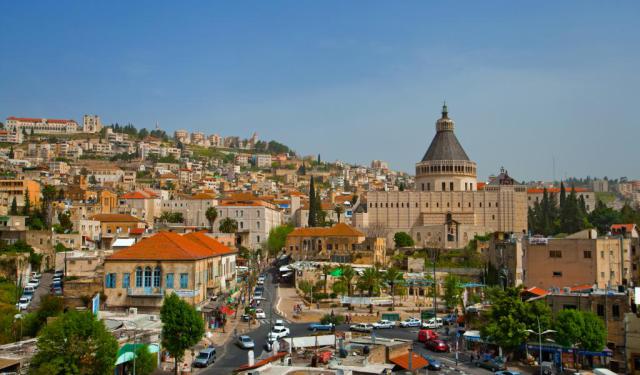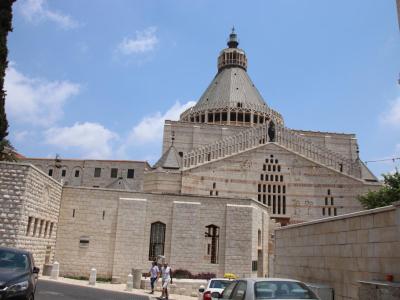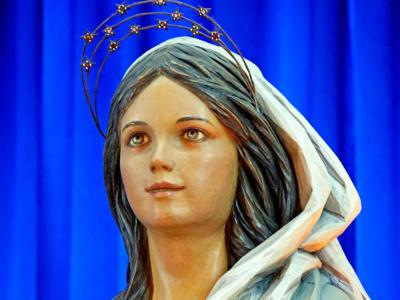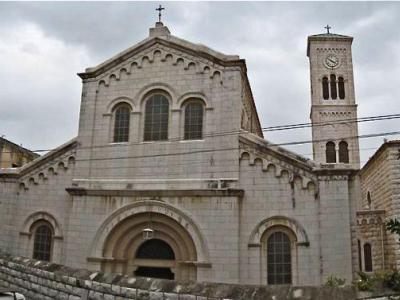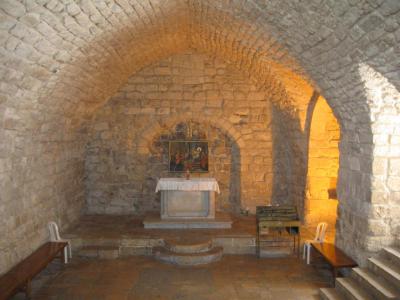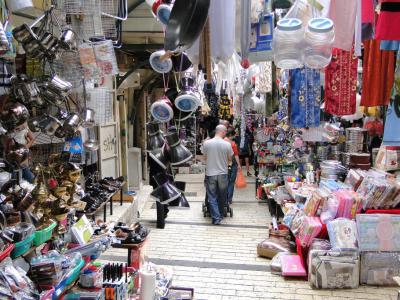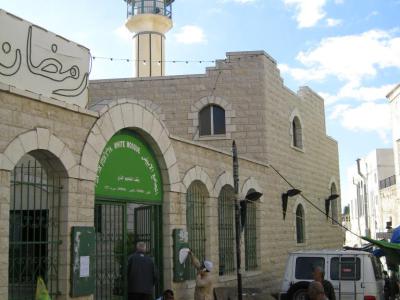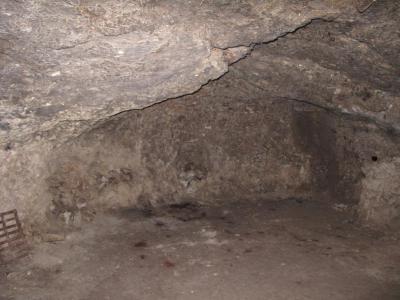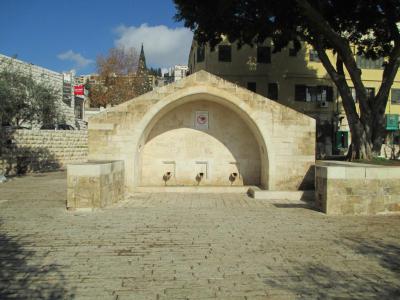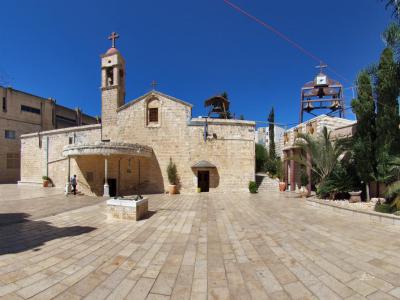Nazareth Introduction Walking Tour (Self Guided), Nazareth
Welcome to Nazareth, a city steeped in history and cultural significance. Known as Nazerat in Hebrew and En-Nasra in Arabic, this town in the north of Israel boasts the largest Arab population in the country – a mix of Christian and Muslim Arabs.
As the childhood home of Jesus Christ, Nazareth holds a special place in the hearts of Christians worldwide and has been a center of Christian pilgrimage since antiquity.
The name "Nazareth" is believed to have originated from the Hebrew word "nétser," which means a shoot or branch, possibly referencing the prophecy of the Messiah coming from the line of David. Alternatively, it could derive from the verb "natsár," meaning "watch, guard, or keep," suggesting either a "watchtower" or "guard place" on a hill or a "preserved, protected" position due to its secluded nature.
Originally a Jewish village during Roman and Byzantine times, Nazareth rose to prominence during the Crusades and later experienced fluctuations under various rulers. The efforts of Zahir al-Umar, a mid-18th century Arab governor of northern Palestine, led to its growth into a bustling town, further expanded by European investments in the 19th and 20th centuries.
The “city of churches,” Nazareth is renowned for its array of shrines and revered sites commemorating biblical events. The most notable of them, undoubtedly, is the Church of the Annunciation, an architectural marvel built over the site – the Annunciation Grotto – where, according to Catholic tradition, Archangel Gabriel appeared to the Virgin Mary, announcing the birth of Jesus.
Adjacent to the Basilica, the Mary International Center provides insight into the life of Mary, the mother of Jesus. It offers educational and cultural programs, shedding light on the role of Mary in Christian faith and tradition.
Other significant churches include Saint Joseph's Church, believed to stand on the site where Joseph, the earthly father of Jesus, had his carpentry workshop, and the Synagogue Church – the said location of the synagogue where Jesus preached.
After you've filled up on church sightseeing, be sure to make time for strolling Nazareth's market district. Exploring the Old Market, established in the 17th century, offers a glimpse into the vibrant daily life of Nazareth, with its bustling streets filled with merchants and skilled artisans.
Nazareth beckons you to explore its sacred sites and discover the profound significance they hold. Coming as a pilgrim, a historian, or a just curious traveler, you should equally prepare yourself for an unforgettable journey through biblical events and faith in this city.
As the childhood home of Jesus Christ, Nazareth holds a special place in the hearts of Christians worldwide and has been a center of Christian pilgrimage since antiquity.
The name "Nazareth" is believed to have originated from the Hebrew word "nétser," which means a shoot or branch, possibly referencing the prophecy of the Messiah coming from the line of David. Alternatively, it could derive from the verb "natsár," meaning "watch, guard, or keep," suggesting either a "watchtower" or "guard place" on a hill or a "preserved, protected" position due to its secluded nature.
Originally a Jewish village during Roman and Byzantine times, Nazareth rose to prominence during the Crusades and later experienced fluctuations under various rulers. The efforts of Zahir al-Umar, a mid-18th century Arab governor of northern Palestine, led to its growth into a bustling town, further expanded by European investments in the 19th and 20th centuries.
The “city of churches,” Nazareth is renowned for its array of shrines and revered sites commemorating biblical events. The most notable of them, undoubtedly, is the Church of the Annunciation, an architectural marvel built over the site – the Annunciation Grotto – where, according to Catholic tradition, Archangel Gabriel appeared to the Virgin Mary, announcing the birth of Jesus.
Adjacent to the Basilica, the Mary International Center provides insight into the life of Mary, the mother of Jesus. It offers educational and cultural programs, shedding light on the role of Mary in Christian faith and tradition.
Other significant churches include Saint Joseph's Church, believed to stand on the site where Joseph, the earthly father of Jesus, had his carpentry workshop, and the Synagogue Church – the said location of the synagogue where Jesus preached.
After you've filled up on church sightseeing, be sure to make time for strolling Nazareth's market district. Exploring the Old Market, established in the 17th century, offers a glimpse into the vibrant daily life of Nazareth, with its bustling streets filled with merchants and skilled artisans.
Nazareth beckons you to explore its sacred sites and discover the profound significance they hold. Coming as a pilgrim, a historian, or a just curious traveler, you should equally prepare yourself for an unforgettable journey through biblical events and faith in this city.
How it works: Download the app "GPSmyCity: Walks in 1K+ Cities" from Apple App Store or Google Play Store to your mobile phone or tablet. The app turns your mobile device into a personal tour guide and its built-in GPS navigation functions guide you from one tour stop to next. The app works offline, so no data plan is needed when traveling abroad.
Nazareth Introduction Walking Tour Map
Guide Name: Nazareth Introduction Walking Tour
Guide Location: Israel » Nazareth (See other walking tours in Nazareth)
Guide Type: Self-guided Walking Tour (Sightseeing)
# of Attractions: 9
Tour Duration: 1 Hour(s)
Travel Distance: 1.1 Km or 0.7 Miles
Author: DanaOffice
Sight(s) Featured in This Guide:
Guide Location: Israel » Nazareth (See other walking tours in Nazareth)
Guide Type: Self-guided Walking Tour (Sightseeing)
# of Attractions: 9
Tour Duration: 1 Hour(s)
Travel Distance: 1.1 Km or 0.7 Miles
Author: DanaOffice
Sight(s) Featured in This Guide:
- Church of the Annunciation
- The Mary International Center
- St. Joseph's Church
- Synagogue Church
- Old Market
- White Mosque
- Holy Caves of Nazareth
- Mary's Well
- Greek Orthodox Church of St. Gabriel
1) Church of the Annunciation (must see)
The Church of the Annunciation stands as a monumental tribute to the biblical event believed to have occurred within its sacred walls. Crowned by a towering cupola, the church is situated over the cave traditionally identified as the dwelling place of the Virgin Mary. This hallowed site is where, according to tradition, the archangel Gabriel delivered the divine message to the young Mary, informing her that she would become the mother of the Son of God. In response to this profound revelation, Mary uttered her consent, saying, "Let it be done to me according to your word."
The Gospels of Matthew and Luke differ in their accounts of Joseph and Mary's residence before the birth of Jesus. However, the Gospel of Luke places them in Nazareth, and early pilgrims began journeying to this location to venerate the site of the Annunciation. The Church of the Annunciation, boasting the title of the largest church in the Middle East, features a commanding cupola that dominates the entire cityscape.
Constructed over a decade in the 1950s and 60s, the church's architectural style is characterized as "Italian brutalist," utilizing exposed and unfinished concrete to accentuate the raw beauty of natural elements. The building replaced an older church dating back to 1730, and Pope Saint John XXIII, intrigued by the archaeological potential, initiated an exploration of the site when it was opened. Despite records indicating the visitation of pilgrims to the area as early as the fourth century, no comprehensive historical study had been conducted prior to this examination.
The Church of the Annunciation stands as a spiritual and architectural masterpiece, inviting pilgrims and visitors from around the world to experience the profound significance of the Annunciation within its sacred confines.
The Gospels of Matthew and Luke differ in their accounts of Joseph and Mary's residence before the birth of Jesus. However, the Gospel of Luke places them in Nazareth, and early pilgrims began journeying to this location to venerate the site of the Annunciation. The Church of the Annunciation, boasting the title of the largest church in the Middle East, features a commanding cupola that dominates the entire cityscape.
Constructed over a decade in the 1950s and 60s, the church's architectural style is characterized as "Italian brutalist," utilizing exposed and unfinished concrete to accentuate the raw beauty of natural elements. The building replaced an older church dating back to 1730, and Pope Saint John XXIII, intrigued by the archaeological potential, initiated an exploration of the site when it was opened. Despite records indicating the visitation of pilgrims to the area as early as the fourth century, no comprehensive historical study had been conducted prior to this examination.
The Church of the Annunciation stands as a spiritual and architectural masterpiece, inviting pilgrims and visitors from around the world to experience the profound significance of the Annunciation within its sacred confines.
2) The Mary International Center (must see)
The Mary International Center, situated adjacent to the Basilica of the Annunciation, stands as a testament to the rich history and significance of the Holy Land, particularly in the context of the lives of Mary and Jesus. Established by the French religious community of Chemin Neuf, the center is endorsed by various religious denominations in the region.
Housed in a converted 17th-century building, the Mary International Center unfolds the narrative of Mary's journey through the Holy Land and provides a captivating audio-visual tour that delves into the life of Mary and Jesus. The center comprises four floors dedicated to immersive experiences and educational exhibits.
A noteworthy feature is the hour-long show spread across four rooms, incorporating surround sound, wide-screen cinema, and 3D effects. This multimedia presentation is available in eight different languages, ensuring a diverse and inclusive experience for visitors. The content of the show takes participants on a visual and auditory exploration of Mary's journey, fostering a deeper understanding of the historical and cultural context.
The center also boasts an outdoor viewing platform that offers a unique perspective on recent excavations. These excavations have revealed the remains of an early Roman home dating back to the time of Jesus. This discovery holds particular significance, representing the first house of its kind ever unearthed in Nazareth.
An additional highlight is the extensive rooftop garden surrounding the center's chapel. This serene space provides visitors with a tranquil environment to wander, reflect, and appreciate the spectacular views of the Basilica of the Annunciation and the city of Nazareth.
Housed in a converted 17th-century building, the Mary International Center unfolds the narrative of Mary's journey through the Holy Land and provides a captivating audio-visual tour that delves into the life of Mary and Jesus. The center comprises four floors dedicated to immersive experiences and educational exhibits.
A noteworthy feature is the hour-long show spread across four rooms, incorporating surround sound, wide-screen cinema, and 3D effects. This multimedia presentation is available in eight different languages, ensuring a diverse and inclusive experience for visitors. The content of the show takes participants on a visual and auditory exploration of Mary's journey, fostering a deeper understanding of the historical and cultural context.
The center also boasts an outdoor viewing platform that offers a unique perspective on recent excavations. These excavations have revealed the remains of an early Roman home dating back to the time of Jesus. This discovery holds particular significance, representing the first house of its kind ever unearthed in Nazareth.
An additional highlight is the extensive rooftop garden surrounding the center's chapel. This serene space provides visitors with a tranquil environment to wander, reflect, and appreciate the spectacular views of the Basilica of the Annunciation and the city of Nazareth.
3) St. Joseph's Church (must see)
Saint Joseph's Church is believed to be located at the site where Joseph, the earthly father of Jesus, once had his home and carpentry workshop. The church is closely associated with the history of the Holy Family, as it is believed to have been the residence of Joseph and, subsequently, the home of Mary after their marriage. This sacred space is alternatively known as the Church of Nutrition and the Church of Joseph's Carpentry.
Saint Joseph's Church is part of the same complex as the Basilica of the Annunciation and the Franciscan convent Terra-Santa. The courtyard surrounding the church showcases architectural artifacts uncovered during excavations, providing glimpses into the historical layers of the site.
The present-day church, constructed in 1914, stands on the remnants of a Crusader Church, which, in turn, was built on a series of caves. These caves likely served as storage spaces during Biblical times and possibly housed Joseph's carpentry workshop. Visitors can explore the crypt beneath the church, accessible by a stairway, offering a view of the caves through a grille in the floor.
The church's interior features stained glass windows and paintings depicting various scenes involving Joseph, such as his wedding to Mary, scenes of familial moments, and Joseph showing Jesus the art of carpentry. Notably, the Dream of Joseph is also portrayed, adding a spiritual dimension to the artistic representation.
A stairway further descends to a crypt, revealing a pool or basin with a black and white mosaic floor. This pool, believed to date back to the 1st century AD, is thought to have served as a baptistery. The mosaic floor depicts a ladder, symbolizing the spiritual ascent of new converts to Christianity. The discovery of these ancient elements suggests that Christians may have gathered at this site for worship even before the town had official churches, indicating a rich history of Christian presence in the region.
Saint Joseph's Church is part of the same complex as the Basilica of the Annunciation and the Franciscan convent Terra-Santa. The courtyard surrounding the church showcases architectural artifacts uncovered during excavations, providing glimpses into the historical layers of the site.
The present-day church, constructed in 1914, stands on the remnants of a Crusader Church, which, in turn, was built on a series of caves. These caves likely served as storage spaces during Biblical times and possibly housed Joseph's carpentry workshop. Visitors can explore the crypt beneath the church, accessible by a stairway, offering a view of the caves through a grille in the floor.
The church's interior features stained glass windows and paintings depicting various scenes involving Joseph, such as his wedding to Mary, scenes of familial moments, and Joseph showing Jesus the art of carpentry. Notably, the Dream of Joseph is also portrayed, adding a spiritual dimension to the artistic representation.
A stairway further descends to a crypt, revealing a pool or basin with a black and white mosaic floor. This pool, believed to date back to the 1st century AD, is thought to have served as a baptistery. The mosaic floor depicts a ladder, symbolizing the spiritual ascent of new converts to Christianity. The discovery of these ancient elements suggests that Christians may have gathered at this site for worship even before the town had official churches, indicating a rich history of Christian presence in the region.
4) Synagogue Church
The Synagogue Church is a small Christian church known by its distinctive name, denoted by the embedded sign above its doorway reading "the synagogue." Currently under the administration of the Melkite Greek Catholic Church, this sacred space holds historical and spiritual significance tied to Christian traditions and the life of Jesus.
The structure of the Synagogue Church features a sunken floor, approximately 1.5 meters below ground level, suggesting a layered history that may include construction atop a Crusader church dating back to the 12th century. The church's custodianship has transitioned over time, initially under the control of the Franciscans until the 18th century when it was passed to the Greek Catholics by ruler Daher al-Omar.
According to Christian tradition, the Synagogue Church stands on the ruins of the ancient Nazareth synagogue where Jesus is believed to have studied and prayed. One significant event associated with this location is the delivery of Jesus's famous sermon on a Shabbat day (Saturday), recounted in Matthew 13, Mark 6, and Luke 4. In this sermon, Jesus declared himself as the Messiah based on Isaiah 61, addressing his Jewish village members. The impact of this proclamation stirred intense emotions among the listeners, leading to an attempt to harm Jesus. The accounts suggest that the infuriated crowd sought to throw him over a cliff, but he miraculously escaped.
The church's connection to the "silent years" of Jesus, a period with limited historical documentation, adds an air of mystery to the site. In 570, an Italian visitor reported on the Synagogue Church, mentioning the presence of the original Bible and noting the bench where Jesus was said to have sat.
The structure of the Synagogue Church features a sunken floor, approximately 1.5 meters below ground level, suggesting a layered history that may include construction atop a Crusader church dating back to the 12th century. The church's custodianship has transitioned over time, initially under the control of the Franciscans until the 18th century when it was passed to the Greek Catholics by ruler Daher al-Omar.
According to Christian tradition, the Synagogue Church stands on the ruins of the ancient Nazareth synagogue where Jesus is believed to have studied and prayed. One significant event associated with this location is the delivery of Jesus's famous sermon on a Shabbat day (Saturday), recounted in Matthew 13, Mark 6, and Luke 4. In this sermon, Jesus declared himself as the Messiah based on Isaiah 61, addressing his Jewish village members. The impact of this proclamation stirred intense emotions among the listeners, leading to an attempt to harm Jesus. The accounts suggest that the infuriated crowd sought to throw him over a cliff, but he miraculously escaped.
The church's connection to the "silent years" of Jesus, a period with limited historical documentation, adds an air of mystery to the site. In 570, an Italian visitor reported on the Synagogue Church, mentioning the presence of the original Bible and noting the bench where Jesus was said to have sat.
5) Old Market
Established in the 17th century, the Old Nazareth Market stands as one of Israel's most captivating markets, enticing not only tourists but also serving as a vibrant hub for locals from Nazareth and the surrounding regions. Nestled in the bustling alleys directly north of the Basilica, the Old Nazareth Market offers a unique opportunity to immerse oneself in the ambiance of a working Oriental bazaar in Israel.
In its earlier days, the market was organized into distinct districts, each dedicated to specific themes such as the Brides’ Market, the Vegetable Market, the Tinsmiths’ Market, and the Carpenters’ Market. While the Vegetable Market remains a prominent feature, the delineation of sections is now more symbolic, with the entire market recently undergoing renovation in preparation for millennium celebrations and a visit from Pope John Paul II.
The market's diverse array of stores presents a treasure trove of goods, ranging from kitchenware, vegetables, candy, and sweetmeats to toys, embroidered cloth, silverware, coffee, herbs, scarves, and drums. Skilled tradesmen, including knife-makers, tailors, and shoe-repairmen, showcase their expertise, contributing to the market's vibrant atmosphere.
The entrance on El Bisharra Stret is renowned for a cluster of traditional sweet stores, where visitors can indulge in the famous hot Nazareth knafeh. As one explores the main street and ventures towards the end, turning right and then left leads to a small alley (6133) where artisans, including metal smiths, continue their age-old crafts.
In its earlier days, the market was organized into distinct districts, each dedicated to specific themes such as the Brides’ Market, the Vegetable Market, the Tinsmiths’ Market, and the Carpenters’ Market. While the Vegetable Market remains a prominent feature, the delineation of sections is now more symbolic, with the entire market recently undergoing renovation in preparation for millennium celebrations and a visit from Pope John Paul II.
The market's diverse array of stores presents a treasure trove of goods, ranging from kitchenware, vegetables, candy, and sweetmeats to toys, embroidered cloth, silverware, coffee, herbs, scarves, and drums. Skilled tradesmen, including knife-makers, tailors, and shoe-repairmen, showcase their expertise, contributing to the market's vibrant atmosphere.
The entrance on El Bisharra Stret is renowned for a cluster of traditional sweet stores, where visitors can indulge in the famous hot Nazareth knafeh. As one explores the main street and ventures towards the end, turning right and then left leads to a small alley (6133) where artisans, including metal smiths, continue their age-old crafts.
6) White Mosque
Nestled in Harat Alghama, also known as the "Mosque Quarter, the White Mosque stands as a testament to Ottoman-inspired craftsmanship that permeates the city. Beyond its role as a place of worship, the White Mosque actively serves the Muslim community of Nazareth.
Distinguished by its cream-colored walls, green-trimmed dome, and a pencil-shaped minaret, the White Mosque showcases the intricacies of Ottoman architecture. A beacon of religious and communal significance, the mosque attracts a steady congregation for daily prayers, with 100 to 200 worshippers attending noon and afternoon services. The Friday sermon, a congregational highlight, draws an impressive gathering of 2,000 to 3,000 individuals.
Steeped in history, the mosque houses a museum that meticulously documents Nazareth's recent past, providing visitors with insights into the rich heritage of the region. Its construction dates back to the latter half of the eighteenth century, financed by Sulayman Pasha al-Adil, the Egyptian Ottoman ruler. Overseeing the project was Sheikh Abdullah al-Fahoum, the high commissioner of Nazareth, who became its trustee through a waqf, a form of endowment.
Constructed between 1804 and 1808, the White Mosque became a testament to Sheikh Abdullah's vision for a new era symbolized by "white," representing purity, light, and peace. His tomb, a poignant reminder of his legacy, resides within the mosque's courtyard. Following his passing in 1815, Sheikh Amin al-Fahoum assumed the responsibility of managing the mosque's affairs.
Today, the White Mosque remains an integral part of the al-Fahoum family waqf, encompassing other significant structures such as the khan of the pasha on Casa Nova Street. Administered by one of Sheikh Abdullah's descendants, ʾAtif al-Fahoum, the mosque continues to stand as a symbol of unity and a beacon of cultural and spiritual heritage in the vibrant city of Nazareth.
Distinguished by its cream-colored walls, green-trimmed dome, and a pencil-shaped minaret, the White Mosque showcases the intricacies of Ottoman architecture. A beacon of religious and communal significance, the mosque attracts a steady congregation for daily prayers, with 100 to 200 worshippers attending noon and afternoon services. The Friday sermon, a congregational highlight, draws an impressive gathering of 2,000 to 3,000 individuals.
Steeped in history, the mosque houses a museum that meticulously documents Nazareth's recent past, providing visitors with insights into the rich heritage of the region. Its construction dates back to the latter half of the eighteenth century, financed by Sulayman Pasha al-Adil, the Egyptian Ottoman ruler. Overseeing the project was Sheikh Abdullah al-Fahoum, the high commissioner of Nazareth, who became its trustee through a waqf, a form of endowment.
Constructed between 1804 and 1808, the White Mosque became a testament to Sheikh Abdullah's vision for a new era symbolized by "white," representing purity, light, and peace. His tomb, a poignant reminder of his legacy, resides within the mosque's courtyard. Following his passing in 1815, Sheikh Amin al-Fahoum assumed the responsibility of managing the mosque's affairs.
Today, the White Mosque remains an integral part of the al-Fahoum family waqf, encompassing other significant structures such as the khan of the pasha on Casa Nova Street. Administered by one of Sheikh Abdullah's descendants, ʾAtif al-Fahoum, the mosque continues to stand as a symbol of unity and a beacon of cultural and spiritual heritage in the vibrant city of Nazareth.
7) Holy Caves of Nazareth
The Holy Caves of Nazareth serve as the focal point of ancient Nazareth, revealing a fascinating narrative of an underground city that played a crucial role in the city's history. Constructed by the ancient Nazarenes, this underground city was a strategic marvel, offering a haven for its inhabitants. The caves, once discovered, were subsequently sealed, preserving their secrets for centuries. Today, their rediscovery provides clear evidence that Nazareth existed as an underground city both before and long after the birth of Jesus.
The significance of these caves is underscored by their role as a sanctuary for Christians fleeing persecution during the 1st century. Among the remarkable features within this subterranean complex is a cave that was unearthed in 1863 beneath the Greek Orthodox archdiocese. This cave, possibly the first of its kind, is believed to have served as a place of worship and communication for underground communities.
The archaeological exploration of these caves has revealed intriguing elements, including two tanks and a corner resembling a kitchen, shedding light on the daily lives of the ancient inhabitants. The extensive network of galleries within the underground city is vast, with unverified claims suggesting connections to significant sites such as the Greek Orthodox Church of the Annunciation and the Annunciation Basilica.
While these caves are not currently open for visitation, knowledgeable guides offer insights into the rich history of the site and ongoing research.
The significance of these caves is underscored by their role as a sanctuary for Christians fleeing persecution during the 1st century. Among the remarkable features within this subterranean complex is a cave that was unearthed in 1863 beneath the Greek Orthodox archdiocese. This cave, possibly the first of its kind, is believed to have served as a place of worship and communication for underground communities.
The archaeological exploration of these caves has revealed intriguing elements, including two tanks and a corner resembling a kitchen, shedding light on the daily lives of the ancient inhabitants. The extensive network of galleries within the underground city is vast, with unverified claims suggesting connections to significant sites such as the Greek Orthodox Church of the Annunciation and the Annunciation Basilica.
While these caves are not currently open for visitation, knowledgeable guides offer insights into the rich history of the site and ongoing research.
8) Mary's Well
Mary's Well, also known as "The spring of the Virgin Mary," is a revered site associated with a Christian tradition linked to the apocryphal Gospel of James. According to this tradition, Mary, the mother of Jesus, received the announcement from Archangel Gabriel at this location, an event known as the Annunciation. The well has historical and religious significance and has been associated with narratives from the Infancy Gospel of Thomas.
Located just below the Greek Orthodox Church of Saint Gabriel, Mary's Well holds a central place in Christian heritage. For centuries, the well was fed by an aqueduct connected to a spring and served as a local watering hole for Palestinian villagers. The well has undergone two reconstructions in the 20th century, in 1967 and 2000, with the current structure symbolically representing the original.
There are multiple sites popularly known as Mary's Well, including the spring beneath the Greek Orthodox Church of the Annunciation, the well structure in the plaza south of it, and a presumed spring beneath the Basilica of the Annunciation. This article primarily focuses on the well structure in the plaza, which has been dry since the 1990s. Once located outside the urban center of Nazareth, Mary's Well was a popular square and meeting place for the Palestinian community until the Nakba and has since become a symbol of the city.
Located just below the Greek Orthodox Church of Saint Gabriel, Mary's Well holds a central place in Christian heritage. For centuries, the well was fed by an aqueduct connected to a spring and served as a local watering hole for Palestinian villagers. The well has undergone two reconstructions in the 20th century, in 1967 and 2000, with the current structure symbolically representing the original.
There are multiple sites popularly known as Mary's Well, including the spring beneath the Greek Orthodox Church of the Annunciation, the well structure in the plaza south of it, and a presumed spring beneath the Basilica of the Annunciation. This article primarily focuses on the well structure in the plaza, which has been dry since the 1990s. Once located outside the urban center of Nazareth, Mary's Well was a popular square and meeting place for the Palestinian community until the Nakba and has since become a symbol of the city.
9) Greek Orthodox Church of St. Gabriel
The Greek Orthodox Church of Saint Gabriel shares claim with the Catholic Basilica of the Annunciation to the site of the Annunciation, where the Angel Gabriel reportedly appeared to the Virgin Mary, announcing the birth of Jesus. The church has a rich history, likely dating back to the Byzantine era in Palaestina Prima, experiencing renovations during the Crusades and taking its present shape in the 18th century under the rule of Zahir al-Umar, the Arab governor of the Galilee.
Locally referred to as Kniset el-Rûm, meaning the "Church of the Romans" in Levantine Arabic, the Greek Orthodox Church of Saint Gabriel is positioned above an underground spring. According to Eastern Orthodox belief, this spring is where the Virgin Mary was drawing water at the time of the Annunciation. The water from the spring still flows inside a side chapel of the church and formerly fed the adjacent Mary's Well, which is located 150 yards away.
The underground chapel from the medieval era, containing the spring, is accessible from within the present church. Decorated with ancient Armenian tilework, the chapel features a recessed area below an altar with a semi-circular apse, and a shaft leading down to the spring. Modern decorative murals adorn the walls and ceilings of the 18th-century overground church, with the iconostasis concealing the altar as per Eastern Orthodox tradition. Visitors can observe the tomb of the priest who founded the church along the north wall. The church continues to serve as a place of worship and pilgrimage, preserving its historical and religious significance.
Locally referred to as Kniset el-Rûm, meaning the "Church of the Romans" in Levantine Arabic, the Greek Orthodox Church of Saint Gabriel is positioned above an underground spring. According to Eastern Orthodox belief, this spring is where the Virgin Mary was drawing water at the time of the Annunciation. The water from the spring still flows inside a side chapel of the church and formerly fed the adjacent Mary's Well, which is located 150 yards away.
The underground chapel from the medieval era, containing the spring, is accessible from within the present church. Decorated with ancient Armenian tilework, the chapel features a recessed area below an altar with a semi-circular apse, and a shaft leading down to the spring. Modern decorative murals adorn the walls and ceilings of the 18th-century overground church, with the iconostasis concealing the altar as per Eastern Orthodox tradition. Visitors can observe the tomb of the priest who founded the church along the north wall. The church continues to serve as a place of worship and pilgrimage, preserving its historical and religious significance.
The Most Popular Cities
/ view all
